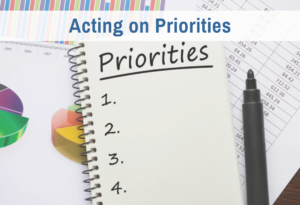A Launcher recently told me that her initiative was going well and she’d added another project. Then she asked, “What’s your short advice for how to be more productive, because I don’t have time for the long version.” In other words, she was now at least marginally overcommitted and didn’t have extra bandwidth to experiment with new tactics and processes.
Implement the 80:20 Rule
If you are a bit overcommitted and you want to be productive, you need to do more than just prioritize your effort. You need to proactively and effectively ration your time among your various projects. To do this, I recommend you ruthlessly apply the 80:20 rule to your list and to every project on your list.
The 80:20 rule (also known as the Pareto Principle) states that 80% of the value of something comes from 20% of the work. The advice is: focus on that 20%.
The rule helps you prioritize among tasks. Alan Lakein recommends that you look at the tasks on your “to do” list. You will see that 80% of the value will come from 20% of the tasks. So do those tasks first and maybe drop the others.
The rule also helps streamline the projects themselves. For many projects, 80% of the value is gained in the first 20% of the work. For example, a clear outline for an article captures most of the information in the article — and takes a fraction of the total effort. This is why slide presentations are so much easier to prepare than articles. Sometimes you can send an outline instead of an article.
Let’s call these 20% solutions with disproportionate payoff the “scaled-down result.”
If you are at all overcommitted, systematically finishing scaled-down results instead of full versions frees up significant time.
Make the 80:20 rule practical by using planned evolution
What if there isn’t a short-term payoff on the task? Not all projects create most of the value in that first chunk of effort. Some tasks get the biggest value in the last chunk of effort.
For example, another Launcher asked about learning human-figure drawing. He said the big payoff for this project comes at the end after you have developed tremendous skill. A similar problem arises with any long-term project. If your goal is to publish a book, it may seem you won’t get the value until you complete the final step — after 100% of the work.
In these cases, you need to work for a long, long time before you see the final payoff. If you stop before the payoff, it may feel like a failure. What do you do in these cases?
My answer: You need to reconceptualize the task so that you can build in a payoff with the first 20% of the effort.
To do this, you first must get clear on what matters most for you. Then you can adjust the goal and redesign the steps to ensure you get more of that payoff sooner.
To take the book example, you can get a payoff earlier in the process but only if you first identify why you’re writing the book.
Some of my speaker friends wrote books so that they’d have something to give to prospective clients. Their books serve as deluxe business cards. They could write mini-books, which are just about 2 inches by 2 inches and only about 500 words. Mini-books are much easier to create and could serve the same end.
Some of my speaker friends wanted merchandise to sell to increase the revenue when they spoke. They could write a chapter for an anthology and sell the anthology. Or they could sell books they recommend. Or they could sell recordings.
My goal for writing my book is to essentialize and organize my material. I get my satisfaction each time I finish an outline or a draft of any part of it — because I am seeing the payoff I want.
Sometimes figuring out how to get an early payoff with a scaled-down result takes creativity. For example, I asked the Launcher who is an artist what value he was seeking by learning advanced drawing skills. He said that he wanted to enjoy his pictures more and express his artistic style better. We talked about how he could change the specific exercises he was doing so that each drawing he did would in fact give him pleasure and show that his style was developing.
Completing a scaled-down result does not mean you have to stop. If the remaining work is still important, you simply iterate. Set another meaningful subgoal you can accomplish in 20% of the remaining time and focus on that. Scale up the first result to be one level better. In this way, you keep doing the most important work first.
I call this process planned evolution. Using planned evolution to ensure short-term value creation is one of the main ways that you set up a virtuous cycle to motivate work on long-term goals.
Planned evolution is even more important if you are juggling multiple projects or you have a hard deadline. Getting an early payoff ensures that you don’t get bogged down on any one project or task. You get natural stopping points to switch tasks, adjust plans, and figure out how to meet all of your commitments. If you have more time, you can iterate. In this way, you make the result the best it can be in the available time.
Accept the inefficiency of overcommitment
You may be thinking this sounds too complicated if you’re just a bit overcommitted.
There is no such thing.
Once you need extra effort to figure out how to squeeze everything into your time, you are definitely overcommitted. You have tipped the balance. Why? Because you increase the proportion of time needed for overhead whenever you add another project to your list.
Let me explain.
Every project you work on could be done most efficiently if it were your only project. You would be more efficient mentally, because everything about the project would stay on your mind. You would not need to warm up the context much at all to dive into the project. You would be more efficient physically, because you could handle external delays. If at a certain step you needed to wait for information or materials from others, you could be ready to pick up and use those external resources as soon as they were available.
But nobody has just one project. When you are comfortably committed, your lesser projects fit easily in the gaps and resting places that naturally come up while working on your top project. You have extra time for any needed warmup of your mental circuits. You don’t need to do a lot of planning because there’s time for starting and stopping.
As soon as you find it difficult to fit everything into your day, you need to add overhead time to coordinate your activity. If one task starts taking longer than you planned, it impacts everything else. Your priorities need to be re-established. Notice this means you lose time due to the task taking extra time plus you lose additional time because you need to figure out what to do about it. That’s why there is no such thing as a little overcommitted. Once it becomes difficult to fit everything in, you suddenly need a lot more planning time.
Of course, one option is to drop some of the tasks that are making you overcommitted. But if you are not willing to do that, the solution is to make sure you get something useful done in a relatively short period of time. Get a scaled-down result. Then you can switch to the other tasks that need your attention. This is the only practical way I know to make progress on multiple projects at once.
Effectiveness comes at a price
The 80:20 rule works. If you think you are a little overcommitted, it will help you get a lot of tasks finished by pushing you to identify and go after scaled-down results. It will create the free time you need to prioritize between the projects. Of course, it does this by leading you to do “B- work.” Reducing quality standards is the logical option when you lack resources.
Good as it is, this advice may not be the silver bullet you are looking for. If you try implementing the 80:20 rule, you may uncover some other issue, such as:
- You don’t like doing B- work, so you refuse to identify or complete scaled-down results.
- You don’t like decommitting, so you refuse to take things off your list.
- You don’t have an effective process for prioritizing your work, so you bog down every time you need to adjust priorities.
- You aren’t good at estimating the time your tasks will take, so you can’t get a handle on priorities in the first place.
- You don’t know how to do planned evolution, so you draw a blank on figuring out a 20% solution.
- Some of the tasks on your list have a lot of old baggage associated with them, so they disrupt everything else.
- You don’t have a process for transitioning between tasks effectively, so you need a huge amount of time to get your head in gear for each project.
Don’t feel bad if you have any of these problems. They are very common. You probably were never taught the specific skills needed to overcome them. I sure wasn’t. But I’ve learned them and lots of other people have, too.
Learning a new productivity skill is a project in itself. If you tend to overcommit, maybe the next project to add to your list is to learn the skills that can change that dynamic over the long term.
* * *
In case it’s not obvious, I offer self-study material for learning all of these skills in the Thinking Lab. If you want more structure, the Launch program is a group-coaching program to help you learn them.









0 Comments